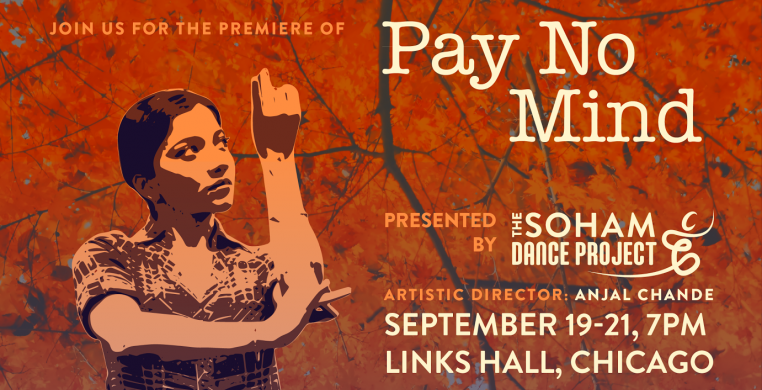“Pay No Mind,” the debut group work of solo artist Anjal Chande’s newly-formed ensemble, Soham Dance Project, has lofty aspirations: the integration of classical Indian bharatanatyam dance and music with contemporary spoken text, music, and movement. What a great idea!
Chande, a multi-talented dancer, choreographer, poet, musician and composer, is clearly on to something, but retaining the richness of traditional forms in the context of contemporary issues and theater aesthetics can be tricky business and may take a little, or a lot, of experimentation to reach full realization.
Ideally, to fully appreciate the scope of her endeavor, one would be well-versed in those traditional forms, program notes aside. The preponderance of men and women in the Links Hall audience dressed in traditional Indian clothing would suggest that many there this past Friday might very well be so versed. Should that be necessary, though?
However we may appreciate the ideas and intentions behind a work of art, the work itself must stand on its own. In the case of “Pay No Mind,” a charming if modest first foray, the balance between vision and outcome is crucial.
We want to embrace the smiles and sunny sparkle of ingenuous wonder that spread across the faces of Chande, Savitha Chelladurai, and Rasika Ranganathan, the three lovely women who comprise the company. Effectively costumed in red, yellow, and green Indian-inspired tunics respectively, with black leggings and bare feet, the three began the piece with a walking progression characterized by the deliberate turned-in and swivel to turned-out articulation of the foot and toes, with ample use of plie, that we recognize as specific to Indian dance. Elaborate finger and hand positions gestured to tradition as well. Fueling the more expansive contemporary movement of sweeping legs, arms, and torsos, the oppositional use of elbows and knees characteristic of Indian dance energized the stage with an engaging use of traditional forms in the more contemporary, high energy sequences.
Chande’s recorded musical score, created to support the choreography, did a nice job of reflecting the youthful insouciance of the three in a “hum-da-dum” modern vocal line, sung by Chande, over an ostinato of traditional sitar sounds, played by musical collaborator Jesse Hunter, with percussion by Karl Olson.
Chande’s self-narration, interspersed as interior monologue in the form of voice-over between movement episodes, provides the textual framework for the theme of “Pay No Mind.” The dreamy, musical lilt of her voice contrasts with the prosaic tone of her text, more reminiscent of journal entries than poetry. Lines like “repetition breeds belief” and complaints of “benign conformity,” and “submission to cues of the world” seem preachy. Over-ambitious metaphors like “we stop noticing we’ve hung up our coats of independence,” veer dangerously close to adolescent angst. The idea of blending interior monologue and movement is appealing, but there’s too much intellectualization in the spoken text, where her dancing provides her with a neat shorthand that gets right to the point, as in the amusing but emotionally-charged copy-cat duet between Chelladurai and Ranganathan.
In a choice that seems to be imitating the traditional storytelling convention of bharatanatyam dance, Chande illustrates her monologues with facial choreography and mimed gestures that slow down the pace of the piece and do nothing to enhance meaning. Where a codified vocabulary of facial expressions may work with the theatrical conventions of the traditional form, once translated into contemporary vernacular, it verges on mugging.
On the other hand, she achieves a startling effect with her innovative and electrifying use of spoken tabla rhythms to underscore some of the most vibrant dance segments that truly achieve the blend of forms she is after. The climax of this is a wonderful repetitive use of the line, “she cannot do it” parlayed into the complex tabla rhythms that at once accompany and propel the excitement of the three women dancing together, conveying a kind of solidarity of purpose and resolve that needs no verbal explanation.
And here lies the crucial question of balance in the blend of traditional and contemporary forms, the choice of which elements strengthen each other, and which linger as good ideas that ultimately prove academic rather than artistically viable. Chande has enough strong material here to keep her probing deeply for that unique blend that reaches a vision worth holding onto.

